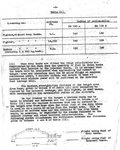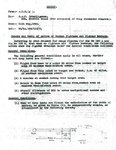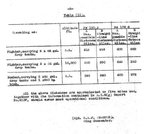Kurfürst
Staff Sergeant
What Kurfurst knows well is that the page he posted is for a test on a Spitfire IX with Merlin 61. The Merlin 61 was rather different to the Merlin 66, the engine which powered most Spitfire VIIIs/IXs/XVIs.
The Merlin 61 had a slightly different supercharger, but more importantly it had an SU float carburettor. The Merlin 66 had a Bendix Stromberg injection carburettor.
The Australian test is for a Spitfire VIII with Merlin 66.
Smokescreen.
What Kurfürst knows is that Hop likes the Spitfire very much, thus Hop would like to to attribute it with properties that are beyond the actual capabilities of the aircraft, and therefore Hop waves around a single test that contradicts all others, and would like to dismiss all those others, via making up that the test is with Merlin 61, a claim Hop repeats over and over again and fail to back up over and over again.
In any case, it doesn`t matter. The range of the Spitfire IX is given in the paper is 450 miles. The range of 'rather different Merlin 66' is given as 434 miles. Hardly a difference. Smokescreen.
http://www.spitfireperformance.com/spitfire-lfix-ads.jpg
The problem is escort range is typically one third of maximum range, which means you need about 1800 mile range to escort bombers to Berlin and back. And you don't want to cruise at 160 IAS, either, because you'll be a sitting duck over Germany at that speed.
That would mean that realistically, the Spitfire, when fitted with the biggest practical, 90 gallon slipper tank, would be good about for a (low speed sitting duck) escort of ca. 300 miles at economical cruise, more realistcally 520/3= 175 miles escort radius. That`s barely reaching into France. Oh sorry, you can`t even reach out that far because then you`ll have obvious problems returning on your 85 gallon internal tangage, draing further by air combat, after getting their on your 90 gallon droptank.
Short ranged indeed. Wasn`t that the point all the way?
From the Spitfire IX/XVI manual:
Later production Mk IX and all Mk XVI aircraft mount two additional fuel tanks with a capacity of 75 gallons (66 gallons in aircraft with "rear view" fuselages), they are fitted in the rear fuselage.
1,054 Spitfire XVIs were made.
The rear tanks were also fitted to the Spitfire XIV, possibly other models as well.
Well, the Mk XVI was in production only from September 1944, and as far as it went, only about 6-7 Squadrons were being operational with the 2nd TAF.
Too late, too few in other words, carrying fuel in an aux tank that made the aircraft a pregnant pig and was useful for 1-way ferry missions only.
Wrong. Source for this claim?
The RAF Spitfire IX manual notes:
"When the rear fuselage tanks are full there is a very marked reduction in longitudinal stability, the aircraft tightens in turns at all altitudes and, in this condition, is restricted to straight flying, and only gentle manoeuvres; accurate trimming is not possible and instrument flying should be avoided whenever possible."
In other words, exactly like the Mustang. Both had to use most of the fuel in the rear tank first.
Except of course the Mustang had plenty of range internal tankage and plenty of range after using up it`s internal fuel tank.
The Spitfire didn`t.
As you can see, the restrictions on the Spitfire with rear fuel tank are not quite as bad as for the Mustang, the Mustang is prohibited from any aerobatics with any fuel in the rear tank, the Spitfire with more than 30 gallons in the rear tank.
Except again of course, that after emptying the rear tank as instructed, the Mustang will have plenty of internal fuel to perform and return from an escort mission, and the Spitfire don`t.
That`s why the Mustang was so important during the war, and why the post-war Spitfires tried to catch up with that.
Depends on the Spitfire. Most Spitfires had only 85 gallons internal because that's all they needed.
And they had thus the shortest radius of action any WW2 fighter I can think of. A bit of a luxury if the target is so far away., isn`t it?
Those that needed more fuel, like the Spitfire VIII, the Spitfire XIV, the recce Spits, got more tankage.
The Spitfire VIII`s use was extremely limited in Europe, and it`s operations largely confined to the PTO, where it`s relatively longer range, compared to the other very short ranged Spitfires, was still laughably inaduquate for the theatre.
As for the Spitfire XIV, even less were around than VIII, appeared even later, and all the extra tankage was used to make up for increased fuel consumption. Having 50% more tankage than the Mk IX, the XIV could just have the same very short range.








